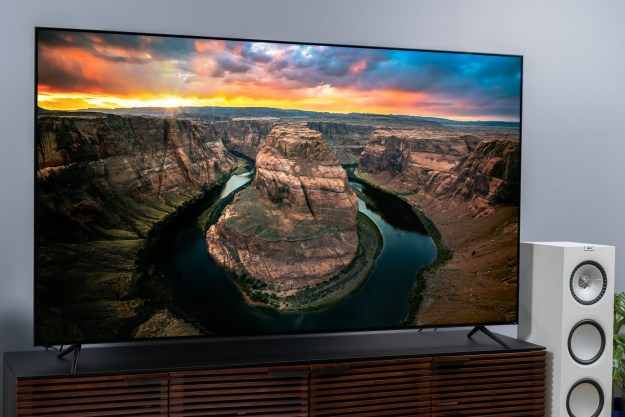
- Powerful brightness
- Intense contrast
- Impressive backlight control
- Extended Color Volume
- Mild motion judder
- Decreased off-angle performance
Vizio’s P-Series Quantum X has historically shattered price-to-performance barriers, and the 2022 model (in this case, the 85-inch P85QX-J01) aims to do more of the same, promising a blistering 3,000 nits of peak brightness with up to 790 zones of local dimming, and industry-leading color volume, all at a price that matches that of the competition’s much smaller screen sizes. It’s fair to wonder: Is this TV too good to be true?
We found out. Read on to see if the Vizio P-Series Quantum X is the right TV for your needs and wants.
Video review
Out of the box
Vizio’s P-Series Quantum X (referred to as the PQX going forward) is currently only available in an 85-inch version which, as I write this review, comes in at just under $3,000 on sale ($3,300 MSRP).
Given the PQX’s powerful, elaborate backlighting system, the TV is neither thin nor light — out of the box, it tips the scales at just over 100 pounds. That being the case, have a friend or neighbor handy if you intend to set this TV up yourself, whether on a media stand or on the wall.
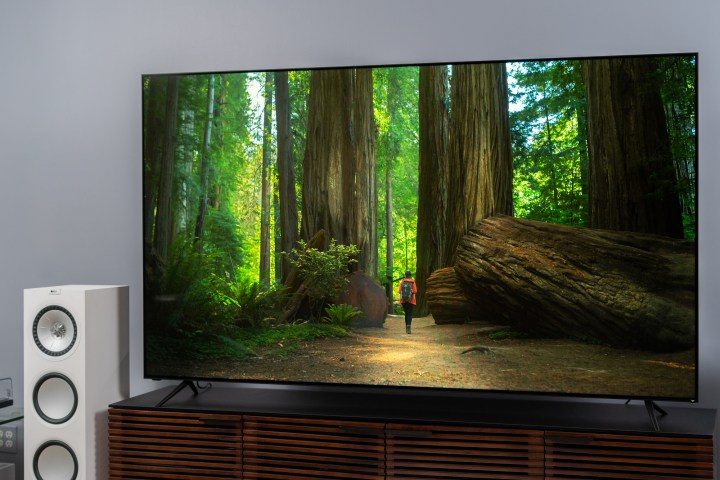
If you’re stand-mounting the PQX, you’ll need at least 66 inches of width and 14 inches of depth to accommodate the TV’s feet, which only have one mounting location under the TV. Once the feet are installed or the TV is mounted to the wall, peeling back a few layers of protective plastic will complete the physical setup of the TV.
From there, setting up Vizio’s SmartCast platform is a relatively straightforward and comparatively brief process. Once connected to the internet via Ethernet or Wi-Fi, the TV will need at least 10 minutes to update itself. From there, an on-screen wizard guides you through the rest, which will include agreeing to terms and conditions that, frankly, are too long and convoluted for most folks to read. As is often the case with Smart TVs, what you give up in privacy, you gain in customized content suggestions. If you have no need for content suggestions, you can kindly tell Vizio to mind its own business by declining to share information. Just be very deliberate about which boxes to tick along the way.
From there, I highly recommend trying out the various picture mode presets that are available. As I’ll discuss shortly, I have a preferred setting, but what’s important is that buyers do not simply accept the out-of-box settings without investigating options that might better suit their viewing needs.
Vizio SmartCast: Much better, but not perfect

In the past, I’ve said that Vizio’s SmartCast smart TV system was frustrating enough to hold me back from recommending its TVs. Not because the platform was poorly laid out or especially hard to make sense of, but because its operation was sluggish and unreliable enough that I could see it causing buyer’s remorse. Thankfully, though, whatever behind-the-scenes issue it was that made Vizio’s TVs frustrating to use for me in the past has been addressed. I don’t think a perfect Smart TV platform exists, and SmartCast isn’t challenging that paradigm, but I didn’t experience any deal-breaking issues with the TV’s onboard apps, navigation, or settings processes during my evaluation.
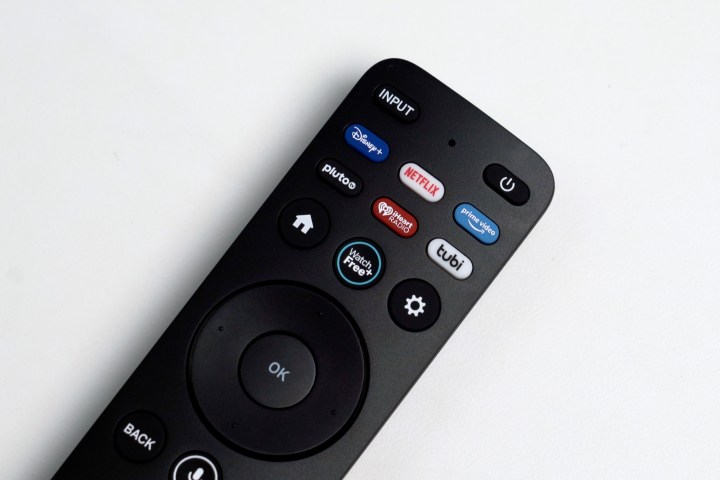
In fact, as smart TV features go, Vizio’s SmartCast is loaded to the hilt. The TV supports most of the apps folks want to use, plus a dizzying selection of less popular apps that are also loaded with content, much of it free to watch. Chromecast and Apple AirPlay 2 support are built-in, as is compatibility with popular digital assistants like Amazon’s Alexa and the Google Assistant. Voice search is also available, triggered by a mic button on the remote, but there’s no built-in mic to worry about disabling over privacy concerns.
Headline features
The Vizio PQX supports all the critical HDR formats, including HDR 10, Dolby Vision, and HLG (for broadcast and YouTube), plus it is one of only a handful of TVs that also supports HDR10 +, giving it a leg up with some enthusiasts who really want support for every available HDR format.
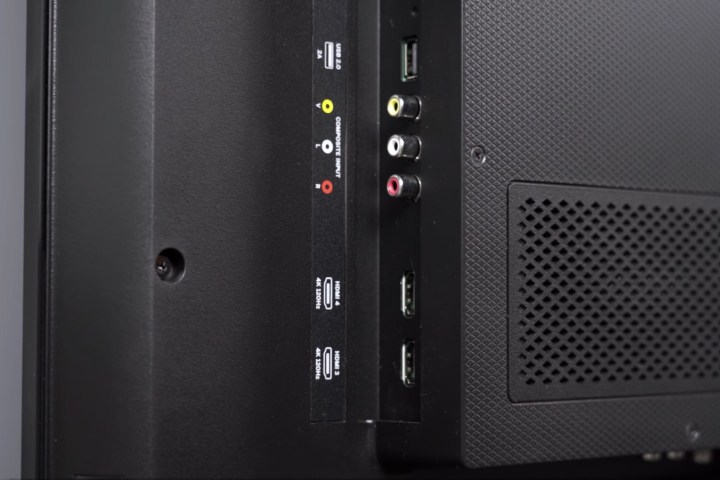
As for HDMI ports, Vizio’s official stance is that all four of the TV’s HDMI ports are HDMI 2.1 compliant, however, only two of the ports (ports 3 and 4) support high-speed HDMI capable of supporting 4K resolution at up to 120Hz. Some people may be pleased to know that those two high-speed ports are independent of the eARC port, which would allow one to connect both an Xbox Series X and a Playstation 5 directly to the TV while sending uncompressed audio to an A/V receiver or soundbar. Others may prefer that the eARC port also support 4K/120 so that they could use their high-end A/V receiver as a switching hub for 4K/120 sources.
The real showstoppers in terms of features and horsepower, however, are in the PXQ’s LED backlight system. While the PQX doesn’t use mini-LED technology yet, it does jam-pack enough LED backlights that the system can be broken down into 790 independently controlled zones, intended to support very precise control of brightness, black levels, and contrast.
That precision is matched up with a head-spinning amount of power, as well — Vizio claims the PQX is capable of peak brightness up to 3,000 nits, which is an astronomically high brightness rating for any TV, let alone one at such a relatively low price. For context, Sony’s vaunted Z9J 8K Master Series TV is capable of achieving somewhere between 3,000 and 4,000 nits but, at 85-inches, it costs more than double the PQX at $8,000. Samsung’s 85-inch 8K Q900B is also capable of such peak brightness, and comes in at about $8,500, though, to be fair, the 2021 Samsung Q900A 8K TV is currently going for $3,000 (same as the PQX) if you can get your hands on one.
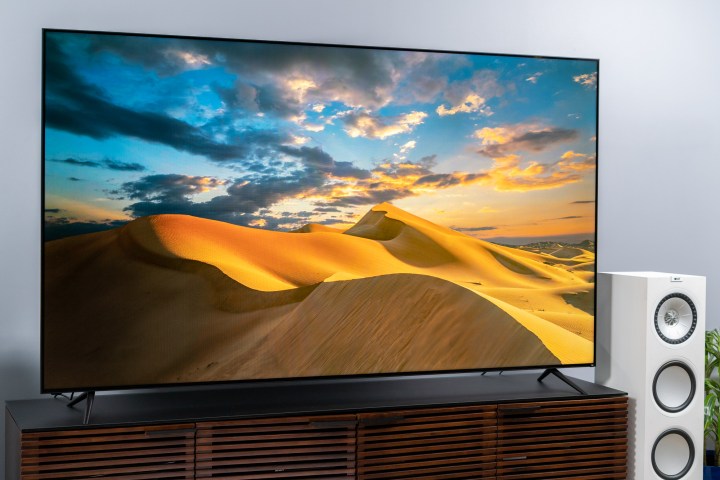
So, on paper, the PQX looks incredibly powerful and capable of surgical precision, with a price tag that more or less laughs at the competition. I’ve always held to the adage that if it seems too good to be true, then it probably is. Is the Vizio PQX an exception to this long-standing rule?
Yeah. For the most part, it is.
Picture quality
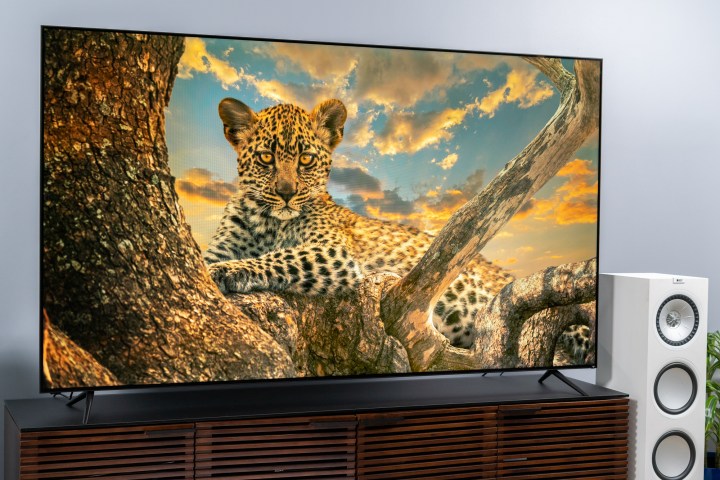
Bottom line: The Vizio PQX looks incredible. Take the price into consideration, and the Vizio PQX defies logic.
Before I proceed, I need to disclose that it would seem the P85QX-J01 review sample I received was somewhat damaged in transit. In my video review (above) I noted that one section of the screen comprising less than 5% of the total screen area appeared to be slightly darkened. Given the non-uniform shape of this “blemish,” it seems clear the screen, not the backlight system, had been compromised. Vizio assures me this issue is a result of screen damage sustained in transit, as the review unit was thoroughly vetted before being sent to me for evaluation and no such issue existed before the unit was shipped.

Vizio’s explanation seems reasonable, however, it did give me some cause for concern since the TV’s box didn’t show obvious signs of abuse consistent with the anomaly. Regardless, since the dark area was restricted to one small portion of the screen, I was able to proceed with my evaluation, which included measurements taken from the unaffected center of the TV’s display area.
Speaking of those measurements: I can confirm that the PQX is quite capable of producing up to 3,000 nits of peak brightness in some of its brighter picture mode presets. However, I only found one picture preset to my liking — Calibrated Dark — and in that mode, the TV measured just about 2,300 nits. While that may seem like a big drop in brightness by the numbers, I can assure you that the PQX was more than sufficiently bright in its Calibrated Dark modes (for SDR, HDR, and Dolby Vision content) when watching real content as opposed to boring test patterns, which fail to tell the whole story as a matter of course.
For those who need all the brightness the PQX can muster to combat bright room conditions, I preferred the Bright picture mode. Usually, I would point to the Calibrated mode (brighter than Calibrated Dark) as the more accurate bright-room preset, but in my experience with the PQX, Calibrated mode had an undesirably warm color temperature, while the Bright mode, surprisingly, was a bit more balanced in the whites.
I found the Vizio PQX extremely fun and satisfying to watch.
Before I continue to comment on picture quality, I want to take a moment to commend Vizio for making it as easy as possible for its customers to get the picture quality they prefer across all content and inputs. When I selected Calibrated Dark in SDR from the home screen, I found that the same mode was applied to SDR, HDR, and Dolby Vision across all internal apps. The same can be said for the HDMI inputs, once a selection is made for an HDMI source. Most other TV brands force users to make independent selections for SDR, HDR, and Dolby Vision content. Vizio’s choice here likely means a more consistent and enjoyable experience for all its customers.
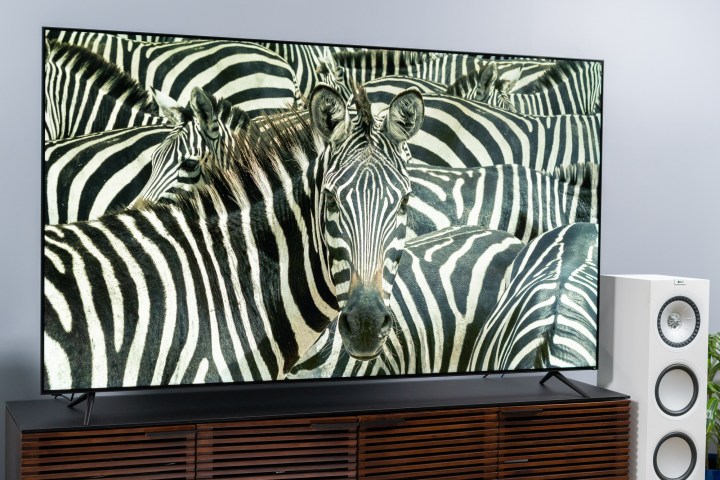
Back to the picture quality: I found the Vizio PQX extremely fun and satisfying to watch. I was concerned that the PQX’s high-brightness muscle might blow me out of the room or create an uncomfortable viewing experience, but Vizio’s picture processing was admirably judicious about how brightness power was applied. I experienced dazzling HDR highlights, brilliant average picture level, and well-saturated, high-brightness colors which are rarely, if ever, visible on a TV, even by today’s standards.
Pleasantly, the Vizio PQX was able to produce both deep blacks and subtle shades of gray, making for pleasing shadow details in dark content, especially in video games. And when there were bright objects on an otherwise dark background (think of a bright moon or starship against the black of space). I experience very little halo effect. Blooming of the backlight system was also a nonissue.
Step off-angle, though, and the PQX’s stunning contrast and backlight control start to fall apart. This is typical of LCD TVs that use a VA-type panel and can be said of any number of other high-performance TVs, and should not be noted as a criticism of the PQX in particular.
Another gripe is the PQX’s slightly juddery motion when motion smoothing is not engaged. It was possible for me to engage a light degree of motion smoothing that reduced stutter and judder without venturing into full-on Soap Opera Effect territory, but I prefer not to use motion smoothing at all as it distorts the familiar cadence of 24 frame-per-second (fps) movie content. Motion issues were much less prevalent in 30 fps TV shows or 60 fps content on YouTube.
Gaming
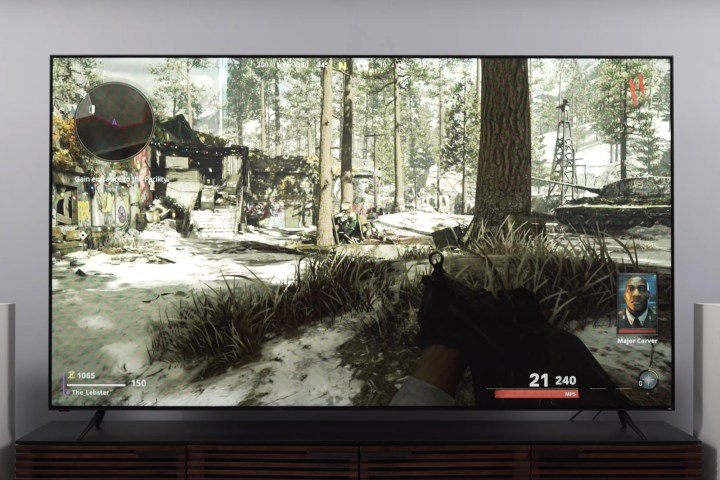
While the Vizio PQX isn’t the most advanced gaming TV you can buy, it’s still got everything most gamers could want, with input lag as low as 8 milliseconds in game mode, support for Variable Refresh Rate (VRR) on next-gen gaming consoles and gaming PCs, and AMD FreeSync Premium certification. I do feel the default picture settings in the TV’s game mode leave something to be desired — the TV seems unnecessarily bright and colors seem a bit blown out — but with some adjustments, it is possible to have both beautiful picture quality and highly responsive gaming performance at the same time.
Sound quality
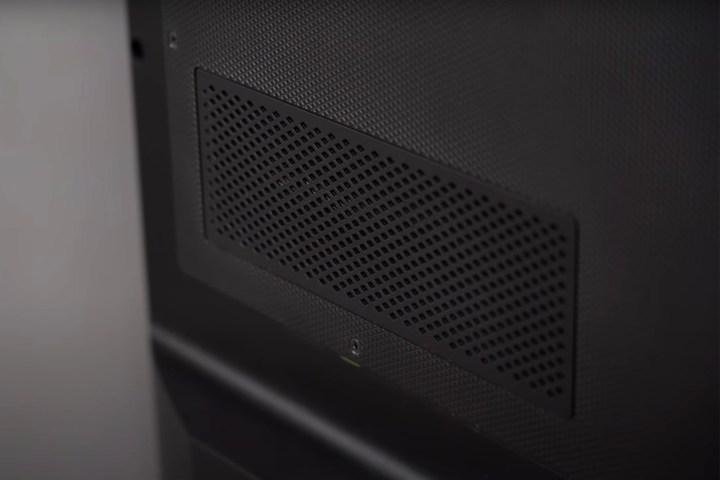
While I have no doubt Vizio put no small amount of effort into making the PQX sound as good as it could without arming it with an expensive onboard audio system, I didn’t find myself impressed enough with the onboard sound to recommend purchasing this TV without also purchasing a soundbar. Fortunately, Vizio makes some of the best-sounding, low-priced soundbars and soundbar surround systems on the market — frequently featured on our list of the best soundbars you can buy — adding a little cost to the package price. In the end, the addition of a soundbar will bring the sound quality on par with the PQX’s picture quality for a minimal additional investment.
Our take
The Vizio PQX offers astounding picture quality for the price, with best-in-class brightness, solid black levels, deep detail, and vivid colors sure to lure in many viewers. If ever there was a video-enthusiast-on-a-budget TV, this would be it. My only real reservations — which are entirely anecdotally based — would be around product reliability and quality control, for which I am not able to methodically test.
Is there a better alternative?
Not at this price. The P85QX offers big performance in a big TV at a relatively small price. The closest competition would likely be one of the TVs in TCL’s XL collection, though the TVs I’ve tested in that series don’t pack as much punch as the PQX.
How long will it last?
The P85QX is the most recent of a string of Vizio TVs that I’ve received in a damaged state, so it is hard not to be a little concerned about buyers’ retail experiences. To be clear, I’m sure Vizio would have provided a replacement unit had I asked for one, as it has done so in the past. In this case, it was simply not necessary.
Should you buy it?
Yes, with a caveat. Buy the Vizio PQX and immediately inspect it to be sure it doesn’t exhibit excessive dirty screen effect. Consider buying the extended warranty to ensure that you’ll enjoy many years of relatively hassle-free enjoyment.




